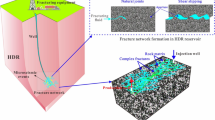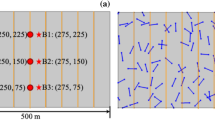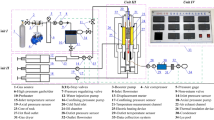Abstract
In geothermal reservoirs, the typically low natural permeability needs to be stimulated for an efficient heat extraction. In this work, the stimulation of heat extraction as well as the associated CO2 sequestration in geothermal reservoirs is studied, based upon supercritical CO2-EGS (enhanced geothermal system) concept in a 3D continuum anisotropic damage-permeability model under thermal–hydraulic–mechanical framework. The developed approach has been applied into the planned Dikili EGS project in Turkey. The simulation results show that a fracture network with a stimulated reservoir volume of 8.71 × 107 m3 is created by injecting 90,000 kg CO2 in 250 h. A priority channel with high gas saturation in the fracture network is formed during heat extraction because of the viscosity difference between CO2 and water. In general, for both water and CO2 injection, the driven pressure and average thermal capacity shows a positive correlation with injection rate, while the eventual produced temperature shows a negative correlation with injection rate. In comparison with water as working fluid for heat extraction, CO2 owns some benefits like low driven pressure and high eventual produced temperature. Besides, a positive correlation between sequestrated CO2 mass and injection rate is observed. Approximately 950, 000 tons of CO2 are geologically sequestrated under injection rate of 100 kg/s over 30 years of production period.























Similar content being viewed by others
References
Altunin VV (1975) Thermophysical properties of carbon dioxide. Publishing House of Standards, Moscow, p 551 (in Russian)
Armienta MA, Villasenor G, Rodriguez R, Ongley LK, Mango H (2001) The role of arsenic-bearing rocks in groundwater pollution at Zimapan Valley, Mexico. Environ Geol 40(4–5):571–581
Bai B, He Y, Li X (2018) Numerical study on the heat transfer characteristics between supercritical carbon dioxide and granite fracture wall. Geothermics 75:40–47
Boch R, Dietzel M, Haslinger E, Goldbrunner JE, Mittermayr F, Fröschl H, Hippler D, Leis A (2017) Scale-fragment accumulations blocking geothermal energy extraction-Interacting steel sulfide corrosion and calcite crystallization. In: Goldschmidt Conference
Borgia A, Oldenburg CM, Zhang R, Pan L, Daley TM, Finsterle S, Ramakrishnan TS (2017) Simulations of CO2 injection into fractures and faults for improving their geophysical characterization at EGS sites. Geothermics 69:189–201
Breede K, Dzebisashvili K, Liu X, Falcone G (2013) A systematic review of enhanced (or engineered) geothermal systems: past, present and future. Geothermal Energy 1(1):4
Brown D (1995) The US hot dry rock program—20 years of experience in reservoir testing. In: World Geothermal Congress pp 2607–2611
Brown D (2000) A hot day rock geothermal energy concept utilizing supercritical CO2 instead of water. In: Proceedings of the twenty-fifth workshop on geothermal reservoir engineering. Stanford University p 233e8
Cao C, Liu H, Hou Z, Mehmood F, Liao J, Feng W (2020) A review of CO2 storage in view of safety and cost-effectiveness. Energies 13(3):600
Chen Y, Hu S, Zhou C, Jing L (2014) Micromechanical modeling of anisotropic damage-induced permeability variation in crystalline rocks. Rock Mech Rock Eng 47(5):1775–1791
Chen L, Wang CP, Liu JF, Liu J, Wang J, Jia Y, Shao JF (2015) Damage and plastic deformation modeling of beishan granite under compressive stress conditions. Rock Mech Rock Eng 48(4):1623–1633
Chen Y, Ma G, Wang H, Li T, Wang Y (2019) Application of carbon dioxide as working fluid in geothermal development considering a complex fractured system. Energ Convers Manag 180:1055–1067
Chiarelli AS, Shao JF, Hoteit N (2003) Modeling of elastoplastic damage behavior of a claystone. Int J Plast 19(1):23–45
Cooper HW, Simmons G (1977) The effect of cracks on the thermal expansion of rocks. Earth Planet Sci Lett 36(3):404–412
Evans KF, Genter A, Sausse J (2005) Permeability creation and damage due to massive fluid injections into granite at 3.5 km at Soultz: 1. Borehole observations. J Geophys Res Solid Earth 110(B4):1–14
Evans KF, Zappone A, Kraft T, Deichmann N, Moia F (2012) A survey of the induced seismic responses to fluid injection in geothermal and CO2 reservoirs in Europe. Geothermics 41:30–54
Gou Y, Hou Z, Li M, Feng W, Liu H (2016) Coupled thermo–hydro–mechanical simulation of CO2 enhanced gas recovery with an extended equation of state module for TOUGH2MP-FLAC3D. J Rock Mech Geotech Eng 8(6):904–920
Grigsby CO, Tester JW, Trujillo PE, Counce DA (1989) Rock-water interactions in the Fenton Hill, New Mexico, hot dry rock geothermal systems I. Fluid mixing and chemical geothermometry. Geothermics 18(5–6):629–656
Guo T, Gong F, Wang X, Lin Q, Qu Z, Zhang W (2019) Performance of enhanced geothermal system (EGS) in fractured geothermal reservoirs with CO2 as working fluid. Appl Therm Eng 152:215–230
Halm D, Dragon A (1996) A model of anisotropic damage by mesocrack growth; unilateral effect. Int J Damage Mech 5(4):384–402
Hofmann H, Babadagli T, Yoon JS, Blöcher G, Zimmermann G (2016) A hybrid discrete/finite element modeling study of complex hydraulic fracture development for enhanced geothermal systems (EGS) in granitic basements. Geothermics 64:362–381
Hou Z, Şen O, Gou Y, Eker AM, Li M, Yal GP, Cambazoğlu S, Were P (2015) Preliminary geological, geochemical and numerical study on the first EGS project in Turkey. Environ Earth Sci 73(11):6747–6767
Itasca (2009) FLAC3D manual, Version 4.0. ITASCA Consulting Group, Inc
Jiang P, Zhang L, Xu R (2017) Experimental study of convective heat transfer of carbon dioxide at supercritical pressures in a horizontal rock fracture and its application to enhanced geothermal systems. Appl Therm Eng 117:39–49
Lee KK, Ellsworth WL, Giardini D, Townend J, Ge S, Shimamoto T, Yeo IW, Kang TS, Rhie J, Sheen DH, Chang C, Woo JU, Langenbruch C (2019) Managing injection-induced seismic risks. Science 364(6442):730–732
Liao J, Hou Z, Haris M, Tao Y, Xie Y, Yue Y (2020) Numerical evaluation of hot dry rock reservoir through stimulation and heat extraction using a three-dimensional anisotropic coupled THM model. Geothermics 83:101729
Luo F, Xu RN, Jiang PX (2014) Numerical investigation of fluid flow and heat transfer in a doublet enhanced geothermal system with CO2 as the working fluid (CO2–EGS). Energy 64:307–322
Magliocco M, Kneafsey TJ, Pruess K, Glaser S (2011) Laboratory experimental study of heat extraction from porous media by means of CO2. In: 36th Workshop on Geothermal Reservoir Engineering
Maleki K, Pouya A (2010) Numerical simulation of damage–Permeability relationship in brittle geomaterials. Comput Geothch 37(5):619–628
Muller N, Qi R, Mackie E, Pruess K, Blunt MJ (2009) CO2 injection impairment due to halite precipitation. Energy Proc 1(1):3507–3514
Olasolo P, Juárez MC, Morales MP, Liarte IA (2016) Enhanced geothermal systems (EGS): a review. Renew Sustain Energy Rev 56:133–144
Pan C, Romero CE, Levy EK, Wang X, Rubio-Maya C, Pan L (2018) Fully coupled wellbore-reservoir simulation of supercritical CO2 injection from fossil fuel power plant for heat mining from geothermal reservoirs. J CO2 Util 27:480–492
Peng DY, Robinson DB (1976) A new two-constant equation of state. Ind Eng Chem Res 15(1):59–64
Pruess K (2006) Enhanced geothermal systems (EGS) using CO2 as working fluid—A novel approach for generating renewable energy with simultaneous sequestration of carbon. Geothermics 35(4):351–367
Pruess K (2007) Enhanced geothermal systems (EGS) comparing water with CO2 as heat transmission fluids
Pruess K, Azaroual M (2006) On the feasibility of using supercritical CO2 as heat transmission fluid in an engineered hot dry rock geothermal system. In: Proceedings, Thirty-First Workshop on Geothermal Reservoir Engineering
Pruess K, Battistelli A (2002) TMVOC, a numerical simulator for three-phase non-isothermal flows of multicomponent hydrocarbon mixtures in saturated-unsaturated heterogeneous media
Randolph JB, Saar MO (2011) Coupling carbon dioxide sequestration with geothermal energy capture in naturally permeable, porous geologic formations: implications for CO2 sequestration. Energy Proc 4:2206–2213
Reid RC, Prausnitz JM, Poling BE (1987) The properties of gases and liquids. McGraw-Hill, New York
Rutqvist J, Tsang CF (2002) A study of caprock hydromechanical changes associated with CO2-injection into a brine formation. Environ Geol 42(2–3):296–305
Rutqvist J, Wu YS, Tsang CF, Bodvarsson G (2002) A modeling approach for analysis of coupled multiphase fluid flow, heat transfer, and deformation in fractured porous rock. Int J Rock Mech Min 39(4):429–442
Rutqvist J, Dobson PF, Garcia J, Hartline C, Jeanne P, Oldenburg CM, Vasco DW, Walters M (2015) The Northwest Geysers EGS Demonstration Project, California: pre-stimulation modeling and interpretation of the stimulation. Math Geosci 47(1):3–29
Schill E, Genter A, Cuenot N, Kohl T (2017) Hydraulic performance history at the Soultz EGS reservoirs from stimulation and long-term circulation tests. Geothermics 70:110–124
Vargaftik NB (1975) Tables on the thermophysical properties of liquids and gases, 2nd edn. Wiley, New York, p 758
Wang H, Lu Q, Li X, Yang B, Zheng Y, Shi L, Shi X (2018) Design of experimental system for supercritical CO2 fracturing under confining pressure conditions. J Instrum 13(03):P03017
Xu T, Pruess K (2010) Reactive transport modeling to study fluid-rock interactions in enhanced geothermal systems (EGS) with CO2 as working fluid. In: Conference Paper Presented at the World Geothermal Congress, Bali, Indonesia pp, 25-29.7
Xu T, Feng G, Hou Z, Tian H, Shi Y, Lei H (2015) Wellbore–reservoir coupled simulation to study thermal and fluid processes in a CO 2-based geothermal system: identifying favorable and unfavorable conditions in comparison with water. Environ Earth Sci 73(11):6797–6813
Yang Y, Chen H, Wang W (2013) Implementation and numerical verfication of Elastoplastic- anisotropic damgae consitutive model in FLAC3D. J Yangtze River Sci Res Inst 30(12):48–53
Zhang K, Wu YS, Pruess K (2008) User’s guide for TOUGH2-MP—amassively parallel version of the TOUGH2 code. Earth Sciences Division, Lawrence Berkeley National Laboratory, LBNL-315E
Zhang YJ, Guo LL, Li ZW, Yu ZW, Xu TF, Lan CY (2015) Electricity generation and heating potential from enhanced geothermal system in Songliao Basin, China: different reservoir stimulation strategies for tight rock and naturally fractured formations. Energy 93:1860–1885
Zhang X, Lu Y, Tang J, Zhou Z, Liao Y (2017) Experimental study on fracture initiation and propagation in shale using supercritical carbon dioxide fracturing. Fuel 190:370–378
Zimmermann G, Blöcher G, Reinicke A, Brandt W (2011) Rock specific hydraulic fracturing and matrix acidizing to enhance a geothermal system—concepts and field results. Tectonophysics 503(1–2):146–154
Acknowledgements
The authors are grateful for the editor and the three anonymous reviewers, whose comments and suggestions are very beneficial for the improvement of the paper. Jianxing Liao and Cheng Cao would like to thank the China Scholarship Council (CSC No. 20170808145, 201808080067) for fellowship support. This present work is funded also by the CAS Pioneer Hundred Talents Program in China and NSFC (No. 51809259).
Author information
Authors and Affiliations
Corresponding author
Additional information
Publisher's Note
Springer Nature remains neutral with regard to jurisdictional claims in published maps and institutional affiliations.
Rights and permissions
About this article
Cite this article
Liao, J., Cao, C., Hou, Z. et al. Field scale numerical modeling of heat extraction in geothermal reservoir based on fracture network creation with supercritical CO2 as working fluid. Environ Earth Sci 79, 291 (2020). https://doi.org/10.1007/s12665-020-09001-7
Received:
Accepted:
Published:
DOI: https://doi.org/10.1007/s12665-020-09001-7




